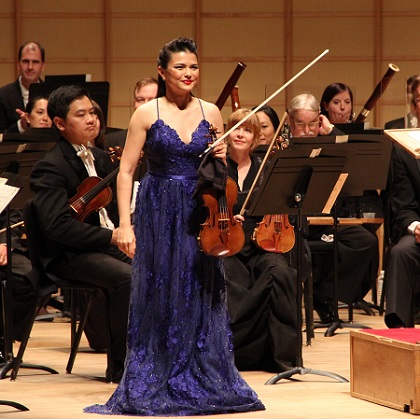 Canada Mendelssohn, Brahms, Schumann: Karen Gomyo (violin), Vancouver Symphony Orchestra / Jeffrey Kahane (conductor), Orpheum Theatre, Vancouver, 19.10.2018. (GN)
Canada Mendelssohn, Brahms, Schumann: Karen Gomyo (violin), Vancouver Symphony Orchestra / Jeffrey Kahane (conductor), Orpheum Theatre, Vancouver, 19.10.2018. (GN)

Mendelssohn – The Fair Melusina Op.32
Brahms – Violin Concerto in D major Op.77
Schumann – Symphony No.1 in B flat major Op.38 ‘Spring’
Violinist Karen Gomyo has become a favorite in Canadian concert halls, a status that now increasingly extends to Europe as well. Born in Tokyo, she grew up in Montreal before moving to the Julliard School at the invitation of Dorothy DeLay. Her captivating stage presence and remarkable virtuosity are the most obvious attributes that keep her in the spotlight, and the range of tone colour that she can draw from her Stradivarius is stunning by any standards. In previous appearances here, she has given performances of brilliance and character, even if her youthful eagerness and a tendency to overemphasis have sometimes compromised interpretative depth. Her current reading of the Brahms Violin Concerto took a large step forward. This was a performance of genuine long-run vision and command, featuring a compelling mix of architecture, feeling and tonal beauty. It was the best performance of the work in Vancouver since Midori’s perceptive traversal over five years ago. Her collaborator was Jeffrey Kahane, who gave her plenty of room to work, while also contributing Mendelssohn’s The Fair Melusina overture and Schumann’s ‘Spring’ Symphony.
One has to get used to certain features of Gomyo’s style. Always technically commanding, the violinist is consistently intense and sometimes feisty, and has a penchant to impart little dramatic pushes and pulls and inflected crescendos to her phrasing and line. Some of this emphasis drives a fine wedge between insight and over adornment. Combined with a cunning legato line, such an arsenal might successfully bring variety and interest to the shorter concertos such as the Mendelssohn, Bruch or Tchaikovsky, but hardly the Brahms or Beethoven, which require a deeper (and more naked) investment from the performer. That is what makes Gomyo’s effort on this occasion an accomplishment. Even the legendary Kyung-Wha Chung, who also imbued works with remarkable passion and technical brilliance in her early days, took many years to fashion a truly satisfying interpretation of the latter two concertos. And in a performance here last year, the estimable virtuoso Ray Chen failed to carry the line of the Beethoven very well because he didn’t fully vanquish the ghost of Paganini in his approach.
The Brahms concerto did not have the most distinguished opening: Kahane’s conducting lacked breadth, and he introduced an unmarked accelerando halfway through the opening tutti. But Gomyo’s entrance was commanding, with a strong arch to her phrasing and a careful sculpting of the dramatic lines. There were some of the violinist’s characteristic dramatic inflections, but these gained increased meaning as the cantabile lines began to flow. More and more the purity and intimacy of her lyrical expression held hands with her raw cutting strength, and the violinist had to exert less effort to put telling detail in place. Her playing was always precise and tonally beautiful, but the outstanding feature was how invested in the work she became and how coherently her interpretation fit together. Gomyo never failed to bring out the sinew and majesty of her part, yet she always ensured that a natural lyrical flow and concentration were maintained. Her closing cadenza was an absolute triumph.
The Adagio started plainly, but the violinist’s entry firmly established the appropriate bittersweet yearning, and she developed the somber emotional shadings with poignancy. Except for a few slides and expressive rubato that struck me as slightly too glamorous, there was great simplicity and refined beauty in her playing, and it was her tenderness and commitment that allowed the movement to achieve real suspension. One should feel a strong sense of release on entering the finale, and I really felt it here. Gomyo’s playing started out with so much joy and delight – and such graceful elegance too. She could open up all of her technical tricks – including some passages of beautifully-executed spiccati – but they did not compromise the wonderful rhythmic bounce of it all; in fact, they just enhanced the pleasure. It was a compelling and distinctive performance with a strong grip over the whole while managing to draw one in more and more as it progressed. From a technical perspective, the concerto could not be better played: the violinist’s ease in execution was disarming, and there was not a single smudge or intonation difficulty from beginning to end.
Jeffrey Kahane certainly played his part in the overall integration of the concerto, but his conducting was fairly no-nonsense throughout, with rhythmic grip and energy but less open to nuance or expressive development. The Fair Melusina has never been one of Mendelssohn’s most enticing overtures, but its historical exposure was doubtlessly enhanced by Sir Thomas Beecham’s early love of the piece and his two recordings. It starts from beguiling naturalistic allusions (coaxed from the winds) and then gives way to long stretches of energy and drive, ending in relative tranquility. It was the uncompromising drive that dominated Kahane’s performance, tending to make the work less colourful and varied than it actually is. The closing performance of Schumann’s ‘Spring’ Symphony was cut from the same cloth, tightly-knit and rhythmically cogent (recall George Szell), but not cultivating much of the sweet expectancy or gentle whim and caprice that one identifies with the season or the composer. The first three movements tended to the forthright, but the finale made its mark through vibrant energy and frisson. Here the orchestra distinguished itself by an increasingly attentive response from the strings and an impressive contribution from the brass.
It was an invigorating programme all told, but the big story was Karen Gomyo’s Brahms.
Geoffrey Newman
Previously published in a slightly different form on http://www.vanclassicalmusic.com.